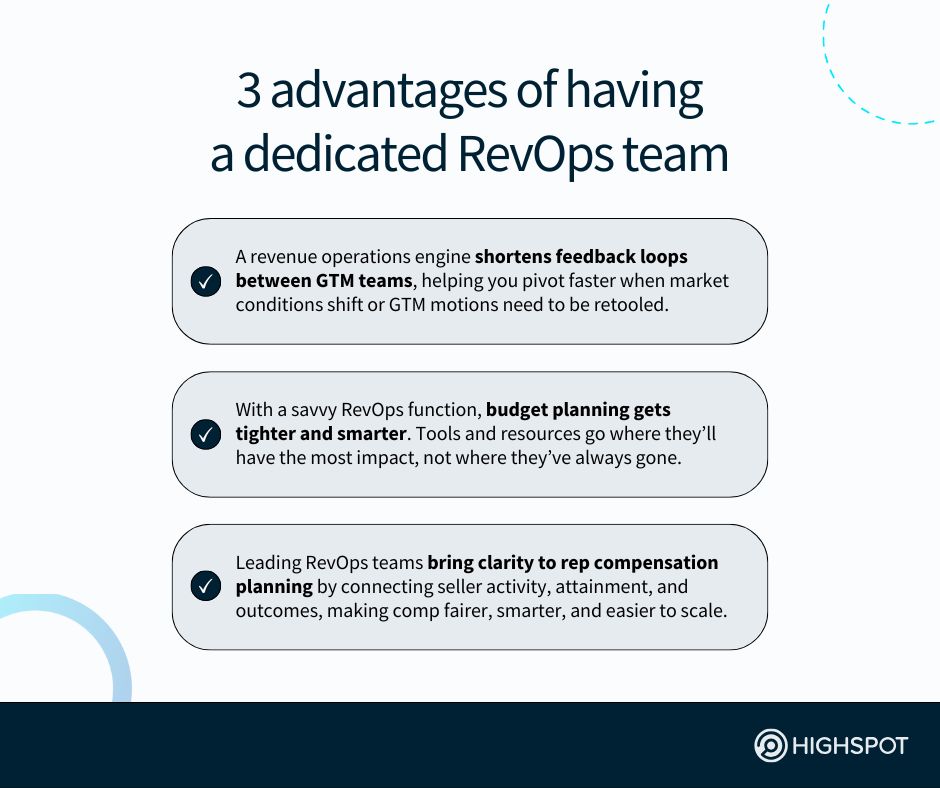Key Takeaways
- Revenue operations brings structure, speed, and accountability to the chaos of GTM, aligning teams, systems, and data to drive repeatable outcomes and clear ROI across the entire customer lifecycle.
- A strong RevOps framework empowers GTM leaders to unify metrics, streamline workflows, and move from scattered efforts to a coordinated, performance-driven engine that scales with precision.
- Building a modern revenue operations strategy means shifting from reactive reporting to real-time execution, equipping every role with insights, playbooks, and actions that move deals forward and drive growth.
Revenue operations (RevOps) has quietly become the connective tissue of modern go-to-market strategies, holding together what once unraveled under the weight of silos, inconsistent execution, misallocated resources, and unclear ROI.
From unused tools and tech gathering dust, to the lack of collaboration and communication among customer-facing teams, GTM leaders know the real cost of wasted effort: deals lost, reps burned out, and initiatives stalled before they ever launch.
That’s where your revenue operations function can truly transform your business for the better—and maximize revenue generation for your company.
From reactive cleanup crew, to proactive performance engine, RevOps liaises closely with both sales operations and marketing operations to better align strategy and execution in ways that actually stick and lead to sustainable, repeatable growth.
Though the road to predictable growth isn’t paved with sales dashboards alone, a unified go-to-market enablement platform with native AI and analytics is what empowers today’s revenue teams—ones like yours—to more effectively equip, guide, coach, and train sellers to succeed, iterate, optimize, and win.
What is revenue operations?
Revenue operations is a strategic function that unifies sales, marketing, and customer success to drive alignment, improve visibility, and remove barriers across the entire customer journey without adding layers of complexity or noise.
RevOps connects the dots between business leaders’ annual sales planning and what actually happens in the field, translating strategy into execution that leads to measurable results and sustainable growth across go-to-market teams.
Revenue operations addresses the messy middle, where misaligned goals, bloated tech stacks, and unclear handoffs usually derail momentum, creating space for operational efficiency improvements and smarter decision-making.
With tight coordination across people, processes, and tools, RevOps ensures sales reps continually close deals faster, marketing teams engage leads smarter, and enablement stays laser-focused on what drives impact.
Implementing revenue operations frameworks
The ideal RevOps framework starts by mapping how deals move across sales, marketing, and customer success: from first touch, to renewal and expansion.
Establishing a revenue-growth discipline requires aligning your revenue function around shared metrics, goals, and workflows from day one.
Strong frameworks automate routine tasks like lead management and opportunity tracking, giving front-line sellers more time to focus on revenue-driving work.
By analyzing data daily, RevOps can identify trends faster, course-correct sooner, and stay tightly aligned on key metrics tied to revenue pipeline progress.
Determining the right RevOps team structure
RevOps teams are structured with specialized leads for operations, systems, enablement, and insights, all reporting to a Chief Revenue Officer or Chief Commercial Officer.
Duties include building workflows, managing data quality, and ensuring the entire GTM engine runs efficiently across all customer-facing functions.
Revenue leaders should keep a close eye on profit margins, ensuring RevOps efforts directly support both top-line growth and bottom-line performance.
An effective structure helps measure success in outputs such as rep activity volume and outcomes like sales funnel efficiency and consistent growth.
Aligning sales, marketing, and customer success
When sales, marketing, and customer success operate in lockstep, the buyer experience improves, and revenue teams operate with much more confidence.
It takes more than meetings to align these teams. It requires a system that prioritizes collaboration, feedback loops, and data-driven decision-making.
RevOps teams help unify handoffs, messaging, and measurement, removing the friction that usually stalls sales pipeline progress and slows deal momentum.
Sales and marketing alignment lets you ID trends early, streamline comms, and ensure no critical insights get lost between tools, teams, or territories.
Leveraging data to drive recurring revenue growth
Revenue teams must build regular customer data analysis into their workflows to uncover friction, flag risk, and surface expansion opportunities.
Advanced analytics empower teams to predict churn, spot upsell signals, and prioritize accounts based on actual buyer behavior, not just gut feel or quota pressure.
Recurring revenue depends on understanding what drives loyalty, and that means tying insights back to the actual actions of front-line sellers.
The top RevOps teams measure success by what moves the needle, tracking retention, customer lifetime value, and all key metrics tied to revenue pipeline progress.
| Revenue operations FAQ | Answer |
|---|---|
| How does RevOps improve sales forecasting accuracy and support more predictable revenue outcomes? | Revenue operations centralizes go-to-market data, eliminates manual reporting, and applies consistent models to enhance forecasting accuracy. By doing so, they help GTM leaders spot risks early, course-correct fast, and drive predictable revenue outcomes quarter after quarter. |
| Why are more go-to-market leaders investing in revenue operations as a strategic growth function? | Go-to-market leaders see RevOps as the backbone of execution, helping to align teams, streamline GTM workflows, and turn insights into action. It’s how high-performing companies drive efficiency, consistency, and measurable impact across the entire revenue engine. |
| What KPIs and metrics should GTM teams use to measure the success of revenue operations initiatives? | Some of the top revenue operations KPIs and metrics to track include pipeline velocity, win rate, quota attainment, time-to-ramp, forecast accuracy, and deal cycle length. When RevOps is working, these metrics improve and link clearly to content, training, and rep behavior. |
| How do revenue operations teams help reduce friction in the sales process and speed up deal cycles? | RevOps removes blockers like bloated tech stacks, inconsistent revenue data management, and clunky marketing-to-sales handoffs. It replaces them with aligned systems, clean workflows, and unified reporting that give reps what they need to sell faster and smarter. |
| What is the ideal revenue operations team structure for large enterprise companies today? | Successful RevOps teams typically include leads for systems, analytics, enablement, and go-to-market strategy. This proven structure gives GTM leaders visibility across functions while ensuring each area—from data to execution—has focused ownership and accountability. |
| What key tools and platforms do Directors of Revenue Operations rely on today to accelerate growth? | Directors of RevOps use a CRM, sales enablement platform like Highspot, revenue and deal forecasting tools, business intelligence dashboards, and automation systems. The most effective RevOps tech stacks combine insights and action to drive GTM consistency and performance at scale. |
| How can RevOps teams build revenue operations strategies that contribute to sustainable business growth? | The best RevOps strategies link every go-to-market initiative and sales motion to business outcomes. They align goals across teams, build systems that scale, and empower GTM roles with real-time insights so that every action, training, and piece of content contributes to growth. |
Why RevOps is such an important and strategic business function today
‘Drive revenue growth’ is the obvious primary objective of today’s revenue operations functions. But the team also impacts other facets of business operations:
- Revenue operations professionals work alongside sales operations to break down silos, align teams, and ensure nothing gets lost in the handoff between functions.
- In a world with growing GTM complexity, RevOps helps put a strong digital selling infrastructure in place—including best-in-class AI sales tools—to support scale without losing speed or agility.
- When done right, RevOps gives reps, marketers, and enablement leaders shared transparency into what’s working—and where they need to shift focus next.
- The best RevOps teams build a sales tech stack that simplifies execution, centralizes insights, and eliminates tool sprawl across the entire GTM motion.
- To create a predictable revenue stream, companies need a function that can align data, forecast accurately, and identify deal risk before it’s too late.
- RevOps leaders are responsible for driving new and extendable revenue growth by optimizing processes, guiding investment, and improving team efficiency across the customer lifecycle.
- Revenue operations plays a central role in managing the entire B2B revenue cycle: from customer retention and expansion, to sales forecasting, pipeline pacing, and target-account data analysis.
At the end of the day, RevOps cares about closing deals with high average contract values that aid their organizations’ commercial transformation.
But to get these results, they must first align sales, marketing, and enablement and empower them with best-in-class go-to-market solutions.
With the use of AI for sales and marketing on the rise, providing these teams with cutting-edge artificial intelligence is one of the premier ways that modern RevOps leaders are setting their GTM teams up for near- and long-term success.

10 RevOps best practices: How revenue operations can drive business growth
“Commercial productivity means doing more of what works,” Highspot’s Turn Strategy Intro Revenue Guide explains. “And that means tracking content usage, monitoring play adoption, and giving managers visibility into winning behaviors.”
With that in mind, here are some tried-and-trie RevOps best practices that, when abided by, can help you consistently accelerate your org’s B2B revenue growth.
1. Balance GTM and revenue data management to unify teams around performance and outcomes
Revenue operations isn’t just a data janitor—it’s the one making sure your sales team, marketing, and enablement folks are actually reading from the same playbook.
With sales ops colleagues, RevOps leaders can align messy metrics, clean up overlapping dashboards, and bring some calm to the chaos of disconnected reporting.
When done right, the sales team gets faster answers, cleaner handoffs, and fewer debates over who owns what stage of the sales funnel.
2. Align enablement and RevOps to scale strategic initiatives with speed and accountability
HackerOne VP of Go-to-Market Strategy Tiffany Jones noted how prioritizing cross-functional collaboration and ensuring enablement, marketing, and sales leverage Highspot in their day-to-day to work with one another has elevated GTM performance and empowered reps to show up smarter and move faster.
“It’s not a waterfall effect where someone’s working on this, and the next team takes it over,” said Jones, regarding HackerOne’s RevOps approach. “They very much partner hand-in-hand to deliver an optimized solution for the sales team.”
3. Automate seller workflows to reduce administrative drag and increase time spent selling
When nearly half (46%) of RevOps directors think their go-to-market processes are overly manual and lack essential marketing and sales automation capabilities, as Forrester’s 2024 Revenue Operations Survey discovered, it’s clear these business leaders must upgrade their GTM tech environments ASAP.
Working alongside their sales enablement team, revenue operations helps automate repetitive tasks like lead management and routing, email follow-ups, and content access (think auto-generated digital sales rooms with deal materials), giving reps more time to sell and less time fighting their tech stack.
4. Equip frontline managers with real-time insights to coach with clarity and improve outcomes
Revenue operations gives frontline managers something more powerful than another spreadsheet: the ability to coach based on what’s really happening.
With real-time data from every rep touchpoint via sales intelligence tools, managers can spot skill gaps faster, deliver targeted feedback, and refine sales strategy in the moment.
This makes BDRs sharper, more confident, and better equipped to hit the mark every time.
5. Use sales scorecards to connect rep behavior, training, and engagement to business impact
Consider the Initiatives Scorecard offered in our agentic GTM platform.
Highspot customer Bunge integrated Highspot with Salesforce to create a single source of truth of revenue data that enabled the company’s sales, marketing, and RevOps leaders to build scorecards tied to all initiatives so they can see what activities and messaging contribute to deal wins and revenue growth.
“The Initiative Scorecard [in Highspot] is a big win for us,” said Zoran Vulic, Bunge’s senior marketing manager. “A year from now, when we’re looking at launching a new product in a new specific market, I have the data to say, ‘Here’s the effort that will be required to get the results we’re looking for.'”
6. Strengthen forecasting by centralizing marketing and sales dashboards into one platform
Bringing marketing and sales dashboards into a single source of truth gives revenue teams unified visibility, sharper insights, and forecasts that are grounded in shared data that can ultimately help improve sales performance.
“Messy data wrecks forecasts, distorts reporting and wastes time,” Forbes Business Development Council’s Thasha Batts wrote. “RevOps must take ownership of data quality by validating pipelines, cleaning records and maintaining accuracy.”
7. Improve customer experience by delivering consistent, data-informed engagement across GTM
Revenue operations helps unify content, training, and conversations so every rep is ready to deliver consistently strong customer experiences.
No more guessing which deck to use or which email sequence to send—RevOps ensures every interaction is grounded in what’s proven to work. That kind of consistency builds trust and removes the friction that usually derails the B2B buying journey.
8. Empower customer success teams with real-time data to improve post-sale engagement
When revenue operations arms your customer success team with real-time data, magic happens: onboarding gets faster, retention gets smarter, and surprises go away.
RevOps makes it easy to see what your sales team promised, how buyers engaged, and what success looks like across the entire lifecycle. Post-sale moments suddenly become proactive, strategic, and incredibly sticky.
9. Track the customer lifetime value of closed-won opportunities to prioritize strategic accounts
Revenue operations turns “won” into “what’s next” by helping teams track the long-term value of every account, not just the initial deal size.
By surfacing patterns in expansion behavior and product adoption, RevOps lets your sales team prioritize the customers most likely to grow with you. That’s how you build a strategy around accounts that pay, stay, and become your loudest fans.
10. Identify customer churn risks early leveraging engagement insights and behavior signals
Revenue operations gives you an early-warning system for customer churn by connecting behavior signals across sales, marketing, and success teams.
When activity drops or buyer behavior shifts, RevOps tools flag the risk so your sales team and your customer success team can jump in, and fast. (Think of it like catching a leaky pipe before it floods the whole house.)
Improving your revenue operations strategy with leading AI-powered tools
As Revenue Enablement Institute Executive Director Stephen Diorio recently wrote, go-to-market team empowerment is how the most successful B2B enterprises not only drive revenue growth but also retain top-performing sellers.
“Create measures that close the loop between seller performance, training effectiveness, and customer outcomes,” Stephen wrote. “One way to better manage the process is by creating a closed-loop feedback system that tracks the adoption of training by reps, the effectiveness of that training in practice, and the specific areas reps need more coaching and reinforcement.”
With a platform like Highspot helping sales managers put a bulk of their rep training and coaching on relative autopilot, thanks to our adaptive learning capabilities and AI sales agents and AI role play, RevOps can breathe easy, knowing their everyone in GTM has the tools, insights, and resources to improve daily.




